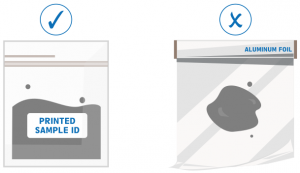Lead Isotope Analysis – Sample Types and Selection
The lead isotopic ratios (e.g. 206Pb/204Pb, 207Pb/204Pb, 208Pb/204Pb) can be measured in various sample types such as igneous and metamorphic rocks, mineral dust, marine and lacustrine sediments, bones, tooth enamel, soil, and others.
Our sample size recommendations are general guidelines. Individual sample size requirements depend on the material type and Pb concentration in the sample. If you measured the Pb concentration in your samples, email us the information PRIOR to submittal so we can give you a better estimate of the required sample size for your material.
Reminders:
DO NOT wrap samples in aluminum or any metal foil. Use weighing paper if you need to wrap them.
Submit samples in a ziplock bag or teflon container with PRINTED SAMPLE ID attached outside the bag.

Always choose the best samples for your research objectives
Our recommended sample sizes assume the material is dry and free of adhering matrix.
Black Shale
200 mg
RECOMMENDED CONTAINERPlastic or glass vials
For the best results, make sure your samples are clean and free from clay particles and other detritus. Must be received dry and homogenized or extra charge will be applied.
ALSO AVAILABLE:Bone (non-ashed)
500 mg
RECOMMENDED CONTAINERZiplock bags
For the best results, make sure your samples are clean and free from soil, clay particles, calcite and other detritus.
ALSO AVAILABLE:Bone (ashed)
200 mg
RECOMMENDED CONTAINERVials
(preferably with screw tops)
Microcentrifuge tubes, or counting slides
Put them inside a labeled Ziplock bag
All bone samples (cremated, intact) must be homogenized and ashed prior to submittal. For the best results, make sure your samples are clean and free from soil, clay particles, calcite and other detritus. Ash samples in a quartz crucible at 850°C for 3 hours and transfer the residues into clean small glass or plastic vials. Samples will be digested in 8 M nitric acid (lower concentrations may be used if the sample contains clay and detritus). A larger sample size is required if we need to ash the samples.
ALSO AVAILABLE:Bulk Carbonates
300 mg
RECOMMENDED CONTAINERPlastic or glass vials
Put them inside a labeled Ziplock bag
For the best results, make sure your samples are clean and free from soil, clay particles, calcite and other detritus. Samples should be homogenized prior to submission.
Burnt & fossilized bone
500 mg
RECOMMENDED CONTAINERZiplock bags
Clean & free from soil, clay particles, calcite and other detritus. For the best results, make sure your samples are clean and free from clay particles and other detritus. Must be received dry and homogenized or extra charge will be applied.
ALSO AVAILABLE:Carbonates:
limestone, corals, flowstones,
cold spring carbonates & cave deposits
300 mg
RECOMMENDED CONTAINERPlastic or glass vials
Clean & free from soil, clay particles, calcite and other detritus. For the best results, make sure your samples are clean and free from clay particles and other detritus. Must be received dry and homogenized or extra charge will be applied.
ALSO AVAILABLE:Ceramic
100-150 mg
RECOMMENDED CONTAINERPlastic or glass vials
Put them inside a labeled Ziplock bag
Ceramic samples need to be homogenized prior to submittal. For effective sample dissolution, high-temperature flux fusion is the method of choice. Homogenized samples will be fused at 1075°C with high-purity lithium metaborate (LiBO2, Puratronic) and ultra-pure grade lithium bromide to ensure complete recovery of the melt. The melt is directly digested in 6 M nitric acid.
ALSO AVAILABLE:Ferromanganese nodules
200 mg
RECOMMENDED CONTAINERPlastic or glass vials
For the best results, make sure your samples are clean and free from clay particles and other detritus. Must be received dry and homogenized or extra charge will be applied.
Glass
100-150 mg
RECOMMENDED CONTAINERPlastic or glass vials
Put them inside a labeled Ziplock bag
Glass samples need to be homogenized prior to submittal. For effective sample dissolution, high-temperature flux fusion is the method of choice. Homogenized samples will be fused at 1075°C with high-purity lithium metaborate (LiBO2, Puratronic) and ultra-pure grade lithium bromide to ensure complete recovery of the melt. The melt is directly digested in 6 M nitric acid.
ALSO AVAILABLE:- None at this time
Igneous and Metamorphic Rocks
50 mg
RECOMMENDED CONTAINERPlastic or glass vials
Put them inside a labeled Ziplock bag
Rock samples need to be homogenized prior to submittal. For effective sample dissolution, high-temperature flux fusion is the method of choice. Homogenized samples will be fused at 1075°C with high-purity lithium metaborate (LiBO2, Puratronic) and ultra-pure grade lithium bromide to ensure complete recovery of the melt. The melt is directly digested in 6 M nitric acid.
ALSO AVAILABLE:Ikaite minerals
300 mg
RECOMMENDED CONTAINERPlastic or glass vials
For the best results, make sure your samples are clean and free from clay particles and other detritus. Must be received dry and homogenized or extra charge will be applied.
ALSO AVAILABLE:Marine and lacustrine sediments
50 mg
RECOMMENDED CONTAINERPlastic or glass vials
Put them inside a labeled Ziplock bag
All organics must be removed from the sample either by ashing or with hydrogen peroxide. All carbonate fractions must be removed if you wish to measure Pb isotopes only on siliciclastic fraction. A larger sample size is required if we need to remove the carbonates and organics from the samples. For effective sample dissolution, high-temperature flux fusion is the method of choice. Sediment samples will be fused at 1075°C with high-purity lithium metaborate (LiBO2, Puratronic) and ultra-pure grade lithium bromide to ensure complete recovery of the melt. The melt is directly digested in 6 M nitric acid.
ALSO AVAILABLE:Metal Artifacts and coins
20 mg
RECOMMENDED CONTAINERPlastic or glass vials
Put them inside a labeled Ziplock bag
For the best results, make sure your samples are clean and free from soil, clay particles, calcite and other detritus. Samples will be digested in 8 M nitric acid (higher concentrations may be used if need be).
ALSO AVAILABLE:- None at this time
Mineral Dust (ashed)
30-50 mg
RECOMMENDED CONTAINERVials
(preferably with screw tops)
Microcentrifuge tubes, or counting slides
Put them inside a labeled Ziplock bag
Aerosol samples collected on filter paper must be ashed entirely prior to submittal. All organics must be removed from the sample either by ashing or with hydrogen peroxide. All carbonate fractions must be removed if you wish to measure Pb isotopes only on siliciclastic fraction. A larger sample size is required if we need to remove the carbonates and organics or ash the samples. For effective sample dissolution, high-temperature flux fusion is the method of choice. Aerosol samples will be fused at 1075°C with high-purity lithium metaborate (LiBO2, Puratronic) and ultra-pure grade lithium bromide to ensure complete recovery of the melt. The melt is directly digested in 6 M nitric acid.
ALSO AVAILABLE:Soil (ashed)
50 mg
RECOMMENDED CONTAINERPlastic or glass vials
Put them inside a labeled Ziplock bag.
All organics must be removed from the sample either by ashing or with hydrogen peroxide. Soil samples need to be homogenized prior to submittal. For effective sample dissolution, high-temperature flux fusion is the method of choice. Homogenized samples will be fused at 1075°C with high-purity lithium metaborate (LiBO2, Puratronic) and ultra-pure grade lithium bromide to ensure complete recovery of the melt. The melt is directly digested in 6 M nitric acid.
ALSO AVAILABLE:Stromatolites
200 mg
RECOMMENDED CONTAINERPlastic or glass vials
For the best results, make sure your samples are clean and free from clay particles and other detritus. Must be received dry and homogenized or extra charge will be applied.
ALSO AVAILABLE:Tissue
500 mg
RECOMMENDED CONTAINERPlastic or glass vials
Less sample material may be required if high lead concentration. Must be received dry and homogenized or extra charge will be applied.
ALSO AVAILABLE:Tooth
100 mg
RECOMMENDED CONTAINERVials, microcentrifuge tubes, counting slides
Must be received dry and homogenized or extra charge will be applied.
ALSO AVAILABLE:Tooth enamel
100 mg
RECOMMENDED CONTAINERVials
(preferably with screw tops)
Microcentrifuge tubes, or counting slides
Put them inside a labeled Ziplock bag
To remove non-biogenic Pb from enamel or bone, samples will be sequentially treated by 0.1 N acetic acid. Please contact the lab if you want to follow different protocols or you prefer to skip this stage.
ALSO AVAILABLE:Travertine
200 mg
RECOMMENDED CONTAINERPlastic or glass vials
Must be received dry and homogenized or extra charge will be applied.
ALSO AVAILABLE:Water
125 mL
RECOMMENDED CONTAINERSmall-neck plastic bottle (HDPE, LDPE, PP)
DO NOT use glass vials
Use any type of small-neck plastic bottle (HDPE, LDPE, PP) to collect your sample. Rinse the bottle with the running sample water prior to collection. Do not add any chemicals to the water, do not acidify the water. Fill the bottle all the way to the top, you may leave a small space at the top (keep the neck of the bottle empty) to allow for any necessary expansion during shipment. Please put the bottles inside a plastic bag and seal the bag with a zip-tie or duct tape. Clearly label both bottle and the plastic bag.
ALSO AVAILABLE:Please consult the lab before submitting samples.
Page last updated: February 2020
